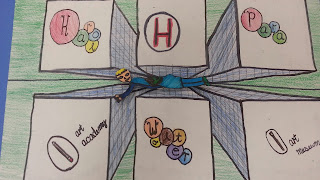Whether you're pushing a cart or teaching in a room, the 1st graders love working with this easy materials: watercolor crayons. They are fascinated with the fact that crayons can turn into paint just with the use of water. I normally like to create this project as my own Mother's Day gift for students to give, but with curriculum and timing, it doesn't always work that way. One thing's for sure...it makes a good spring project.
For this watercolor project, I introduce still life: creating a picture of objects that are not alive. A popular choice is the flower pot, and with spring and summer, flowers are a good option. When students first see my example, they comment that they can't draw it until I show them how simple it can be.
All you need is: white paper (50# weight or more to handle water), pencil, black permanent marker, water color crayons, paintbrushes, and water.
First, I start by drawing the flower pot. I draw a rectangle for the top of the pot, and a square for the bottom of the pot. I explain that the rectangle should not be higher than the middle of the paper so students have room for their flowers.
After the pot is drawn, students draw the ground line, starting from the middle of the square to the edge of the paper of both sides. I give the students the option to draw squares for tablecloth or leave it looking like grass.
Next is the flowers. I show the students a flower at a time, drawing anywhere around the top of the paper, as long as the stems they draw after reach the flower pot. Some simple flowers to draw are the tulips (a "w" with a "u" underneath), a rose (a spiral with a "u" underneath), a tiger lily (three hearts, three stems, three circles), the morning glory (small circle, 5 sticks from the circle, and close it at the ends), and the typical pansies and sunflowers (circle center, circle or pointed petals around the circle). Once all the flowers are drawn, students are asked to create two sticks for a stem that connect to the flower pot, and some added football-shaped leaves for decoration. If the students still have empty space at the top of the paper, I ask for full circle suns, clouds, or birds in the sky.
After their picture is drawn with pencil, I ask them to trace with black permanent makers. Not every teacher uses this step, but I feel at this age, student projects are crisper and neater when using the tracing method.
After the pictures are traced, I hand the students the watercolor crayons. I have the students color in the entire picture first, including the full blue sky reaching the ground. This step is mostly done on day 1.
For day 2, I remind the students on how they need to finish their coloring, then I show them how to use water and paintbrushes to change the crayon coloring into a painting. I instruct how to paint one color at a time, then wash the brush before switching to another color to paint. Once a students' entire picture is colored during class time, I place a bowl of water and paintbrush in front of them, and they go to town.
Here are some of the results from this year!
What's nice about this project (and another reason why I save it for the end of the year) is that it's not that messy. Water is easy to clean up, and you don't have to worry about a heavy mess!



















































